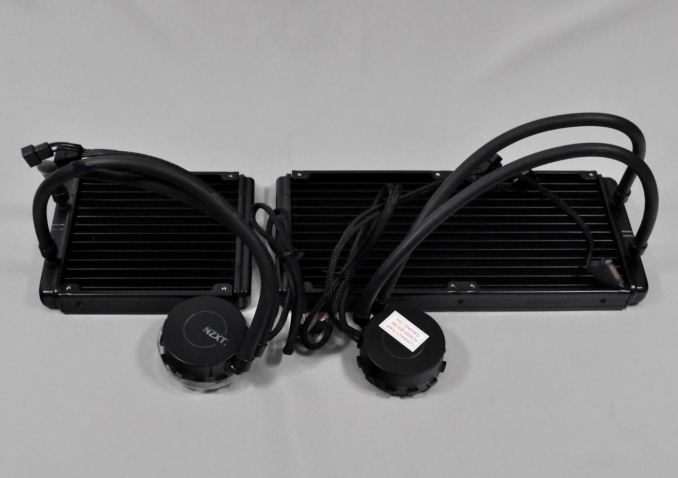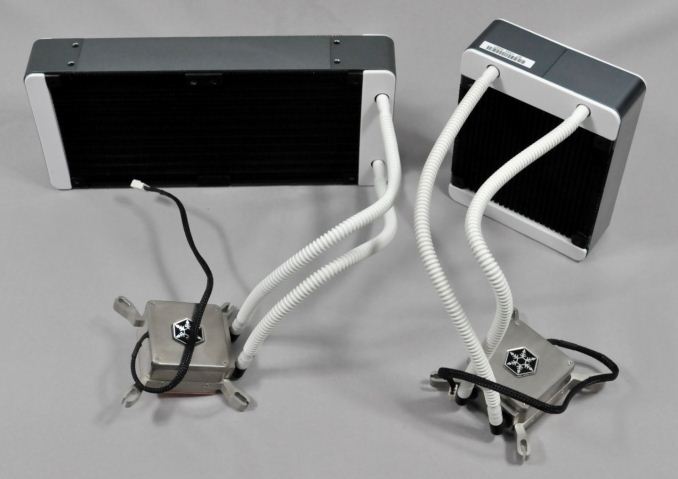Closed Loop AIO Liquid Coolers: 14-way Mega Roundup Review
by E. Fylladitakis on February 12, 2014 7:00 AM ESTEnermax
The two AIO coolers from Enermax that we had the chance to look at share a similarly sized, 120mm x 120mm radiator, yet they are absolutely nothing alike. The Liqmax 120S is a product designed with value in mind, to compete with AIO coolers in the league of the Cooler Master Seidon 120V and the Corsair H75. Its thermal performance is unimpressive, slightly worse than that of the Seidon 120V, yet the noise levels of the Liqmax 120S are considerably lower. It is unable to compete with the dual-fan H75 though, at least not while maintaining similar noise levels.
The Liqtech 120X on the other hand is very impressive, especially in terms of quality and aesthetics. A simple inspection reveals that the radiator and block of the Liqtech 120X are much better made than those of most other kits. It delivers good thermal performance while maintaining very low noise levels, considering the size of its radiator and the use of 120mm fans. The downside is that the Liqtech 120X owes much of its good performance on the extra-thick radiator, which could lead to compatibility problems with some cases if there is not enough clearance.
The only great problem that all AIO coolers from Enermax have is the low availability, as they currently are not available in North America at all and few retailers stock them in Europe. They can be imported to the US from Asia or Europe but that is a financially unrealistic option.
NZXT
NZXT currently offers only two high performance AIO coolers, both with 140mm wide radiators, which limits their compatibility significantly. On the other hand, they are the only coolers with extended (≈ 40cm) tubing, allowing the radiator to reach the front panel of a tower case. Still, the number of cases currently capable of supporting a 140mm wide radiator is quite limited.
Both the Kraken X40 and the Kraken X60 performed well in our tests, offering thermal performance similar to other AIO coolers of the same class. Specifically, they offer lower thermal performance than Cooler Master's 140mm wide coolers but maintain reasonable noise levels, while they display about the same thermal performance as Corsair's offerings but are not as quiet. While better fans could have been selected, NZXT has a tremendous advantage over the competition; the Kraken X40 and Kraken X60 retail for about the same price as other 140mm wide AIO coolers but only NZXT's offerings feature a USB interface. The USB interface allows the user to monitor and fine-tune the performance/noise ratio of the cooling system directly from the desktop, as well as to program custom LED lighting colors and effects.
Silverstone
Silverstone currently offers only two AIO liquid coolers, the Tundra TD02 and the Tundra TD03, both of which we have tested in this review. They are both based on the same design, with their only difference being the size of the radiator. Although the design of the Tundra TD03 is similar to that of the Enermax Liqtech 120X, the aesthetic design of Silverstone's offerings is quite different, going with a white/grey/nickel color theme instead of Enermax's black/red. The OEM behind them might be the same, although that is a mere guess on our part, as the fin design and frame of the radiators are significantly different.
The appearance, feel and quality of the Tundra TD02 and Tundra 03 are outstanding, greatly superior to that of most other kits. On the other hand, the overall performance of these kits actually disappointed us. It is by no means bad, as both of Silverstone's AIO coolers deliver thermal performance comparable to that of other similarly sized kits at reasonable noise levels and are especially efficient under low fan speeds. However, we expected a lot more from kits with radiators this thick and with such a classy appearance.
The mediocre performance may be due to the narrow corrugated tubing, a weak pump, a wrong choice of fans, or any combination of the above, but the fact is that a performance upgrade is required in order to overtake the competition. Furthermore, we are unsure about the white/grey color theme, as it will most likely stand out way too much inside all-black cases and that is not always the desired effect. Still, the balance between quality, performance, and value is very good and Silverstone's AIO coolers will become a favorite among those who want to combine low-noise operation and good looks. Just make sure that the 45mm thick radiators will fit inside your system before purchasing one!













139 Comments
View All Comments
Dustin Sklavos - Wednesday, February 12, 2014 - link
Good lord.If I'd known my successor would produce results this thorough I'd've stepped aside a long time ago.
Really well done piece of work.
E.Fyll - Wednesday, February 12, 2014 - link
Thank you for the praise Dustin, yet I still stand unworthy of it. :)Dustin Sklavos - Wednesday, February 12, 2014 - link
I'm enjoying your work tremendously. Now that I'm at Corsair I'm glad we have someone we can send case/cooling/PSU hardware to that meets and beats the AnandTech standard.creed3020 - Wednesday, February 12, 2014 - link
Yeah Dustin....I have seriously enjoyed your labors here at AT and do miss them. Your successor has changed the paradigm so much that it's hard to compare, but it's a awesome reboot to this area of reviews here at AT.I, however, have to agree with many other commenters that a secondary dataset produced with the same 120mm/140mm fans does have it's merit as it will provide an objective evaluation of the radiator and pumps. This is one area where I am really curious to see quality differences in the products. I am fully aware that each OEM is very careful in their selection of a fan which matches their product. This is not done by lottery, that much is clear to me. The OEM behind the Silverstone/Enermax product intrigues me, as I am a fan of Silverstone products and use their cases exclusively for all of my desktops, gaming PCs, and HTPCs. The Tundra's seems like they are ripe for a revision!
BigLeagueJammer - Wednesday, February 12, 2014 - link
Under Noise Level Reference Values, your first one of <35dB(A) being "Virtually inaudible" doesn't match up with most sources I've seen. Most rate that as "very quiet" and say the limit of human hearing as 10 db(A). If other sources say things like a ticking watch is around 20 db(A) which in a quiet room is easy to hear, then 35 seems too high for your qualification of "virtually inaudible".E.Fyll - Wednesday, February 12, 2014 - link
True, I am afraid that the lot of "copy/paste-ing" online has produced a lot of bad information going around. Some are works of fiction, some are misinterpretations of confused people, some...I don't even want to know.So, copying my answer from above:
"Sub-35 dB(A) levels are generally impossible to notice by a human ear. Sub-30 dB(A) levels are next to impossible to record with anything less than science lab-grade equipment. There is no handheld or desktop dB(A) meter that can perform such readings. If you have seen reviews stating sub-30 dB(A) levels, make sure to check their methodology (given that there is any). Either the meter cannot read lower than 30 dB(A) (and/or will display a bogus reading, as most cheap Chinese meters do) and the review is a fictional text or their methodology is based on dB readings, not dB(A) readings, which is useless to a consumer."
I think it will suffice for me to say that you cannot possibly hear what an instrument designed for this specific purpose cannot even record. In theory, the human hearing threshold is 1 dB(A); in practice however, that is true only for specific frequencies. The background noise of a typical room is almost always above 32-33dB(A).
Jon-R - Wednesday, February 12, 2014 - link
What is your opinion on the tests done over at SilentPCReview? They test using lab-grade equipment. A rundown can be found here: http://www.silentpcreview.com/article875-page2.htm...They use reference fans which measure around 13dBA at their slowest fan speeds, and they don't think highly of AIO water-cooling at all, as none of the tested ones have come close to the best air-coolers when it comes to quiet cooling.
E.Fyll - Wednesday, February 12, 2014 - link
From what I can see, they are using a highly sensitive microphone and a computer's sound card to record the results, connected through an amplifier. Although the equipment is very good, this is not "lab grade equipment" but just a customized setup. A very good setup nonetheless, including an anechoic chamber. They have a microphone with a self-noise of 8 dB, which measures 11 dB(A) inside the aforementioned anechoic chamber.It will suffice to say that their results are just in no way comparable to mine. Actually, as noise level measurements are environment-specific, you should only compare the results of a same setup, never in-between different setups. Unless they are all science labs with multiple ISO certifications, of course. Given that my room floor noise level is over 30 dB(A) and they are using a sub-12 dB(A) anechoic chamber, I believe that I do not have to stress how different the results out of these two setups are.
As far as equipment goes, for example, this is a cheap lab grade sound analyzer and still costs 5 times more than the whole setup that you showed me, microphones and secondary equipment aside:
http://www.nti-audio.com/en/products/flexus-fx100....
Jon-R - Wednesday, February 12, 2014 - link
But you're not saying that their measurements are inaccurate, only that they've got a significantly lower noise-floor than what you're using? So it boils down to the difference between what is considered silent? Because 30dBA is louder than their reference fan it its loudest setting, and far beyond what they consider acceptable. Just as a reference, they measured 43 dBA for the Silverstonde TD03 at 12v, and 30 dBA at 7v.E.Fyll - Wednesday, February 12, 2014 - link
"Inaccurate" is a harsh word when it comes to sound pressure level measurements. Although I would not hesitate to use this word for most other types of tests, there are far too many variables at stake here. I believe that their setup may be better than mine. I am just using a good handheld sound level meter, with the product positioned in the middle of a standard room.I would simply stick with "different".
Sound levels are additive. If you have a noise source of 20 dB(A) and added another source of 20 dB(A), the room noise would not be 20 dB(A) but 23 dB(A). A third source would make it 24.8 dB(A) and so on. So, a fan that would measure 18 dB(A) inside an 12 dB(A) anechoic chamber, will still add to the 30.4 dB(A) floor noise of my room. The difference is the magnitude, as the scale is logarithmic. As you said, the TD03 added about 18 dB(A) and 30 dB(A) to their setup, when it adds 8.3 dB(A) and 17.7 dB(A) to mine, because of the higher background noise. These differences are in no way comparable to each other; that is only possible when the scale is linear. The further you move up the decibel scale, the largest the increase of SPL becomes per single decibel.